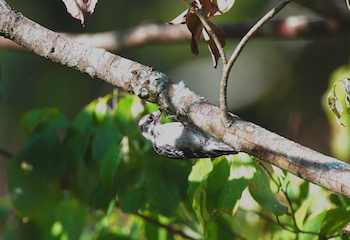
By Terry W. Johnson
The woodpecker we are most apt to see in Georgia is the downy. Although those of us who feed birds are familiar with the feeding habits our smallest woodpecker displays during their brief visits to our feeders, this behavior is very different than when the bird is feeding away from those feeders.
More than 75 percent of the downy woodpecker's diet is comprised of the eggs, larvae and adults of a wide range of invertebrates such as bark beetles, tent caterpillars, ants, spiders, scale insects, corn earworms, snails, fruit borers, codling moths and even flying insects such as moths and mayflies.
Plant material makes up most of the rest of the bird's diet. Downy woodpeckers eat a variety of berries produced by plants such as flowering dogwood, Virginia creeper, sumac and poison ivy. Downies will also eat acorns.
The woodpecker's feeding habits help control insects that are harmful to our food crops. For example, nobody likes to shuck an ear of corn and find an earworm has been munching on the sweet juicy kernels blanketed by the shucks. With that in mind, I am sure you will be happy to learn that downy woodpeckers will literally pluck out the harmful intruders out of ears of corn.
It is also interesting to note that downy woodpeckers help control one of the insects that attack apples. In one study, downy woodpeckers were found to reduce the overwintering population of coddling moths—a serious pest to apples and other fruit—by 52 percent.
One of the downy woodpecker's most intriguing feeding habits is displayed when it is seeking grubs hidden in goldenrod galls. The galls are the large, ball-shaped swollen areas found on the stems of goldenrod stems during the winter. When I was a kid, I called these odd growths head knockers. The grubs overwintering in the galls are an important winter food for downies. Interestingly, if you spot a downy woodpecker pecking at a gall, most likely it will be a male.
Also, if you watch a downy feeding on a gall, you just might see it lightly tap the gall before it tries to dig out the hidden insect. Some experts theorize that the bird does this to assess the size of the grub the gall contains. If this theory is correct, the sound that resonates from the bird’s tapping tells the hungry downy the relative size of the grub hidden inside.
The feeding habits of these bird change with the seasons. During summer, downy woodpeckers glean food more often on the surface of trees and shrubs. However, in the winter months it prefers to extricate insect larvae from dead wood using their saliva-coated tongues.
Also, as a rule, throughout much of the year males typically hunt for food in those areas of the trees where it is most abundant. This means males forage for food in the very tops of trees. Here in the canopy, the thinner bark covering the smaller limbs allows the males to chisel out larvae of wood-boring beetles hiding deeper in the wood. The males are very protective of these choice-feeding locations and will thwart any forays attempted by females trying to enter this domain. This relegates females to the lower portion of a tree (e.g., the trunk and lower limbs), where food is harder to come by.
Another interesting facet of the downy woodpecker's feeding behavior is displayed when they have young in the nest. As you might imagine, adults are kept extremely busy trying to feed the usual clutch of three to six young over the 20–28 days it takes for chicks to develop enough to leave the nest.
The parents begin by feeding their young very small insects. Both the size of insects and the frequency of the feedings increases as time goes on. Even after the young fledge, the parent's job is not completed: They will continue to feed the fledglings for another three weeks.
In colder regions of the country, downy woodpeckers, raise only one brood a year. But that is not the case in the South. Here, downy woodpeckers often nest twice each year.
It is quite obvious that although the downy woodpecker is our smallest woodpecker, it has to be one of our busiest. This fact was noted by John James Audubon. The famous painter and naturalist wrote in his journal that the downy woodpecker was "not surpassed by any of its tribe in hardiness, industry or vivacity."
What’s obvious to me is that when we watch downy woodpeckers feeding at our feeders, we have no inkling what these handsome birds actually go through just to feed themselves and their young.
Terry W. Johnson is a retired DNR program manager and executive director of TERN, the Wildlife Conservation Section’s friends group. Check out past columns, his Backyard Wildlife Connection blog and his book “A Journey of Discovery: Monroe County Outdoors.” His columns are also featured at DNR’s blog, under the Conservation tab. Permission is required to reprint a column.





